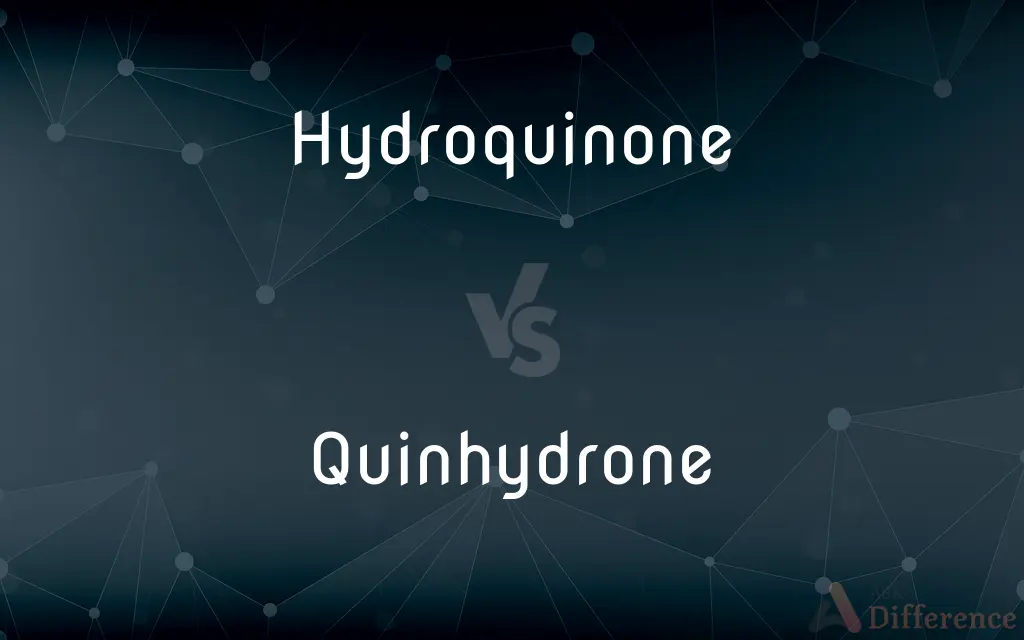Hydroquinone vs. Quinhydrone — What's the Difference?
By Maham Liaqat & Urooj Arif — Updated on April 29, 2024
Hydroquinone is a simple aromatic organic compound used primarily as a reducing agent and skin lightener, while quinhydrone is a complex formed by the combination of hydroquinone and quinone, used in electrochemical measurements.

Difference Between Hydroquinone and Quinhydrone
Table of Contents
ADVERTISEMENT
Key Differences
Hydroquinone, a chemical primarily utilized for its properties as a photographic developer and skin lightening agent, shows a distinct functionality focused on reducing pigment formation and repairing light-sensitive materials. On the other hand, quinhydrone, a compound formed by equimolar combination of hydroquinone and quinone, serves a different purpose, primarily used in pH and redox potential measurements in various solutions.
While hydroquinone acts as an effective reducing agent capable of undergoing oxidation to quinone, quinhydrone uniquely represents a stoichiometric complex, where its properties are exploited in electrochemistry for its stable redox characteristics. This stability makes it valuable in scientific instruments for precise measurements.
Hydroquinone’s applications in dermatology are due to its ability to decrease the production of melanin in the skin, thus lightening hyperpigmented areas. In contrast, quinhydrone's use in electrochemical cells, such as pH meters, is due to its ability to establish a known and stable potential, making it crucial for accurate scientific readings.
The safety profiles of these compounds differ significantly; hydroquinone is subject to controversy and regulation due to concerns over potential carcinogenic effects and skin irritation. Conversely, quinhydrone, being used primarily in controlled laboratory settings, doesn’t come with similar widespread health concerns for general consumers.
Comparison Chart
Chemical Structure
Simple aromatic organic compound
Complex of hydroquinone and quinone
ADVERTISEMENT
Primary Use
Skin lightening, photographic development
PH measurement, redox potential calculations
Mode of Action
Reducing agent that inhibits melanin production
Forms a stable electrochemical cell for measurements
Application Field
Cosmetics, photography
Electrochemistry, laboratory research
Health and Safety Concerns
Regulated due to potential carcinogenic effects
Primarily used in labs, lesser direct health concerns
Compare with Definitions
Hydroquinone
A reducing agent used in photographic developing.
Hydroquinone reduces the silver halides in film during processing.
Quinhydrone
A compound used to measure pH electrochemically.
Quinhydrone electrodes provide accurate pH readings in lab experiments.
Hydroquinone
A skin lightening chemical found in cosmetics.
Creams containing hydroquinone are used to treat hyperpigmentation.
Quinhydrone
An electrochemical standard for redox potentials.
Quinhydrone is used for calibration of redox potential measurements.
Hydroquinone
A potential therapeutic for skin disorders.
Hydroquinone treatments are prescribed for conditions like melasma.
Quinhydrone
A research chemical in analytical chemistry.
Studies involve quinhydrone for developing new types of sensors.
Hydroquinone
An antioxidant component in various industrial applications.
Hydroquinone can prevent polymerization in paints and fuels.
Quinhydrone
A stoichiometric complex of hydroquinone and quinone.
The unique properties of quinhydrone arise from its molecular composition.
Hydroquinone
A chemical intermediate in the synthesis of other compounds.
Hydroquinone is a precursor in the manufacture of certain pesticides.
Quinhydrone
A component in electrochemical cells.
Quinhydrone’s stable properties make it ideal for constructing reference electrodes.
Hydroquinone
Hydroquinone, also known as benzene-1,4-diol or quinol, is an aromatic organic compound that is a type of phenol, a derivative of benzene, having the chemical formula C6H4(OH)2. It has two hydroxyl groups bonded to a benzene ring in a para position.
Quinhydrone
(chemistry) a molecular complex of a quinone and its corresponding hydroquinone
Hydroquinone
A white crystalline phenol, C6H6O2, used as an antioxidant, photographic developer, stabilizer, and reagent.
Quinhydrone
A green crystalline substance formed by the union of quinone with hydroquinone, or as an intermediate product in the oxidation of hydroquinone or the reduction of quinone.
Hydroquinone
(organic compound) The diphenol para-dihydroxy benzene, used as a mild reducing agent in photographic developing; isomeric with catechol and resorcinol.
Hydroquinone
A white crystalline substance, C6H4(OH)2, obtained by the reduction of quinone. It is a diacid phenol, resembling, and metameric with, pyrocatechin and resorcin. Called also dihydroxy benzene.
Common Curiosities
What is hydroquinone used for?
Hydroquinone is primarily used as a skin lightening agent and in photographic development.
Is hydroquinone safe for regular use?
Hydroquinone is regulated in many countries due to concerns about its safety, particularly regarding long-term skin use.
What makes quinhydrone suitable for electrochemical research?
Its stable redox properties make quinhydrone valuable for precise electrochemical measurements and research.
Can hydroquinone cause skin irritation?
Yes, hydroquinone can cause skin irritation and other side effects, which is why its use is closely regulated.
What is the chemical relationship between hydroquinone and quinhydrone?
Quinhydrone is a complex formed from hydroquinone and quinone in an equimolar ratio.
How does hydroquinone affect melanin production?
Hydroquinone inhibits the enzymatic conversion of tyrosine to melanin, thereby reducing pigment formation.
Why is quinhydrone preferred in laboratory pH meters?
Due to its stable and reproducible redox potential, quinhydrone is preferred for precise measurements.
How is quinhydrone used in pH measurements?
Quinhydrone is used in electrochemical cells to provide stable and reliable pH measurements.
Where is hydroquinone commonly found?
Hydroquinone is commonly found in skincare products for lightening dark spots.
Are there alternatives to hydroquinone for skin lightening?
Yes, alternatives like azelaic acid, kojic acid, and vitamin C are used for similar purposes.
What are the environmental considerations for hydroquinone usage?
Hydroquinone can be toxic to aquatic life, so its environmental discharge must be managed carefully.
How does quinhydrone contribute to scientific measurements?
It provides a known and stable potential which is crucial for accurate electrochemical readings.
Is quinhydrone used in commercial products?
No, quinhydrone is mainly used in scientific research and laboratory settings.
What precautions should be taken when using hydroquinone?
It's important to follow dermatological advice and use sun protection while using hydroquinone.
Can quinhydrone be synthesized in a lab?
Yes, quinhydrone can be synthesized by combining hydroquinone and quinone under specific conditions.
Share Your Discovery

Previous Comparison
Hogtied vs. Tied
Next Comparison
Isotonic vs. IsometricAuthor Spotlight
Written by
Maham LiaqatCo-written by
Urooj ArifUrooj is a skilled content writer at Ask Difference, known for her exceptional ability to simplify complex topics into engaging and informative content. With a passion for research and a flair for clear, concise writing, she consistently delivers articles that resonate with our diverse audience.
















































